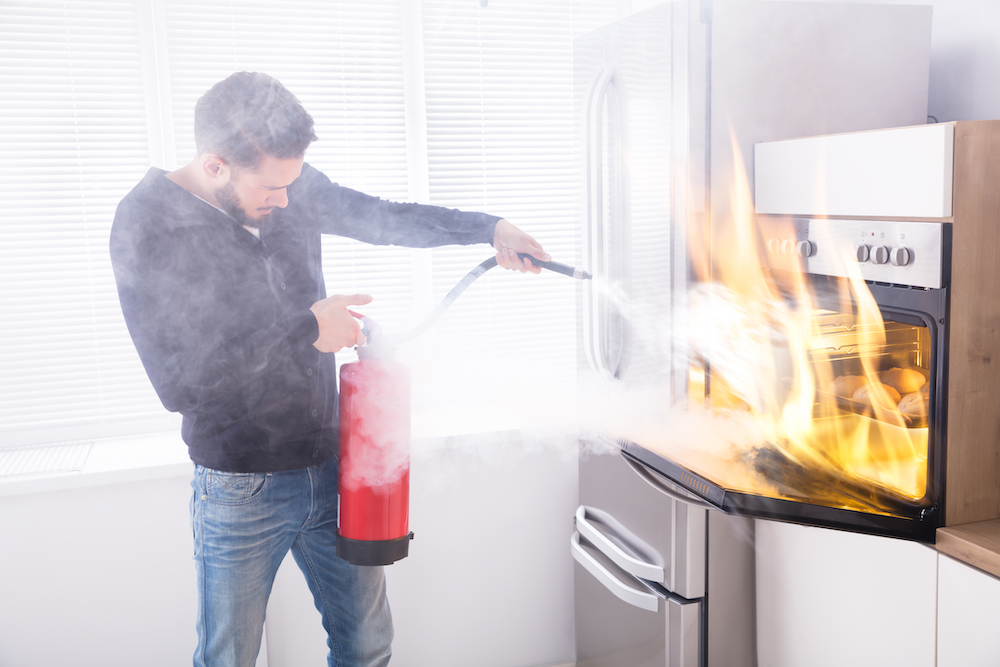According to research conducted by the National Fire Protection Association (NFPA), cooking is the leading cause of home structure fires. As such, it is no surprise that we’ve seen our share of real-life claims confirming this statistic. The disheartening part about their frequency is that cooking fires are also one of the most preventable losses. With regular maintenance and inspections, the use of fire suppression devices, working smoke alarms, and safe cooking practices, one can nearly eliminate the chance of a catastrophic cooking fire. What can investor clients do to make sure their properties and tenants aren’t harmed by an accidental cooking fire?
Cooking Fire Stats
A 2011-2015 National Fire Protection Association study revealed that U.S. fire departments responded to an average of 466 home cooking fires per day, costing over a billion in direct property damage each year and causing thousands of civilian injuries, many of them fatal. The study also discovered the following:
- Reported number of fires involving cooking equipment per year: 170,200
- Number of fire deaths from those fires each year: 510
- Number of civilian fire injuries from those fires each year: 5,470
- The leading contributing factor in these fires and fire casualties: unattended cooking
- Electric ranges were associated with a higher risk of fires than gas ranges
- More than half (55%) of reported non-fatal home cooking fire injuries occurred when the victims tried to fight the fire themselves.
- In 2015, Thanksgiving was the peak day for home cooking fires, followed by the day before Thanksgiving, Christmas Day, Easter, and Christmas Eve.
Regular Maintenance & Inspections
One of the simplest practices to ensure a property is always a safe living space is to perform regular inspections. These are easier if the client or their property manager has already established a good working relationship with tenants. Property owners or managers should be sure to follow any local laws regarding proper notice but shouldn’t shy away from “invading” their tenants’ space. It is the only way to truly see if a property is being kept in good condition, and inspections also allow making sure there aren’t any maintenance items that the tenant hasn’t already reported.
Alarms & Cooking Fire Suppression Tools
Smoke Alarms and CO Detectors
The importance of having both items in constant working order in rentals cannot be overstated. Working smoke alarms cut home fire deaths in half (NFPA). Carbon monoxide (CO) detectors are also key because of the nature of CO’s properties: CO is often known as the silent killer because it is colorless, odorless, and tasteless. Installing interconnected alarms is recommended by the NFPA because when one alarm sounds, it all sounds, alerting the occupants no matter where they are in the house.
Alarms and detectors should be tested monthly, and standard batteries should be changed at least twice a year (Daylight Savings is a good time to do this). Some newer alarms come with five or ten-year batteries, but they still need to be tested regularly. The detectors themselves will also need to be changed out periodically – the typical life of a detector is 10 years. Smoke alarms and CO detectors are often required by your insurer as well as city code, so local guidelines should be followed as well.
Fire Extinguishers
Fire extinguishers can help put out small fires before they become uncontrollable, so providing them in a rental is a must. Clients should educate tenants on how to properly use them before moving in! There are five classes of extinguishers, but ABC or BC are multi-purpose and can put out a variety of fires, so they may be the best choice for this application.
Fire Extinguisher Classes:
- A: ORDINARY MATERIALS – WOOD & PAPER
- B: FLAMMABLE LIQUIDS
- C: ELECTRICAL FIRES
- D: METALS
- K: COOKING OILS
StoveTop FireStop
This inexpensive fire suppression device can help put out a stove top fire before the cook has time to grab a lid or standard extinguisher. StoveTop FireStop products are positioned above the stove, and the flames activate a small fuse on the bottom of the container, which then releases extinguishing powder down onto the stove. There is also a loud “pop” when the container opens, which can alert the distracted cook so they can return to the kitchen to turn off the burners. Learn more about StoveTop FireStop HERE.
Fire Escape Plans & Practice Drills
Property owners know the floor plan of their property better than anyone, and they should share what they know with tenants. Two escape routes should be identified out of each room, if possible, and tenants should be advised to keep escape routes unblocked when considering where to place furniture. Tenants may roll their eyes at “Safety Sam” ways, but this advice may save their lives!
The client is not expected to run fire drills for tenants, but they can lead them to information about fire escape planning for their safety and the safety of the property. Click HERE for The NFPA’s page on Basic Fire Escape Planning.
Cooking Safety
During colder months, most (if not all) cooking is done indoors. When warmer weather arrives, people fire up the grill more frequently. Both types of kitchens have their own set of fire risks. Thanksgiving is the leading day of the year for home fires involving cooking equipment (NFPA), while summer cookouts often involve both the grill outdoors and the stove indoors. To help tenants cook safely year-round, investor clients should share the following cooking tips for both indoor and outdoor cooking areas.
10 Tips for Cooking Safely Indoors
- TEST SMOKE ALARMS TO BE SURE THEY ARE WORKING before guests arrive.
- STAY IN THE HOME when using the oven and check on dishes frequently.
- STAY IN THE KITCHEN when cooking on the stovetop to keep an eye on the food.
- USE A TIMER TO HELP MULTI-TASK. Many meals include multiple dishes cooked at once – a lot to keep track of!
- ASK A RELIABLE “SOUS CHEF” TO HELP IN THE KITCHEN. Four eyes are better than two.
- KEEP OVEN MITTS, WOODEN UTENSILS & OTHER FLAMMABLE ITEMS AWAY FROM THE STOVETOP.
- KEEP THE FLOOR CLEAR to not trip over kids, toys, pocketbooks, or bags.
- KEEP KIDS AWAY FROM FIRE HAZARDS & OTHER DANGEROUS ITEMS:
- The stove – 3 feet or more from a hot oven is a good rule of thumb.
- Hot food & liquids – you don’t want burns from steam or the splash of vegetables, gravy, or coffee.
- Knives – any pointy object perfect for sword fighting should be off-limits.
- Electric cords – you don’t want them pulling an electric knife, coffee maker, or plate warmer down from the counter.
- Matches and lighters – these should be kept up high in a locked cabinet.
- Candles – never leave a child alone in a room with a lit candle.
- KEEP A LID OR COOKIE SHEET CLOSE BY IN CASE A SMALL FIRE STARTS. Flames can be smothered by sliding them over the pan and turning off the burner.
- FIRES CAN SPREAD QUICKLY, SO WHEN IN DOUBT, JUST GET OUT! When leaving the home, the door should be closed behind, get to a safe location, and call 9-1-1.
Wrap Up
By sharing the above advice on performing routine inspections and maintenance with your investor clients, they can then pass it on to tenants. These valuable fire safety tips can avoid the all-too-common – and very costly cooking fire, keeping your clients’ properties fire-free and helping tenants avoid injuries, too.





